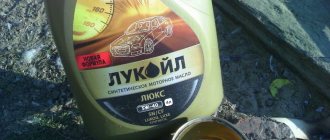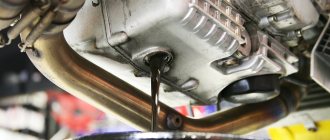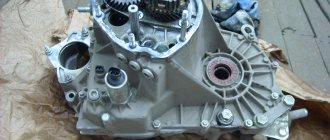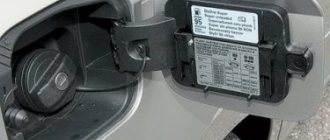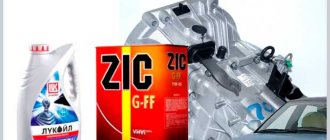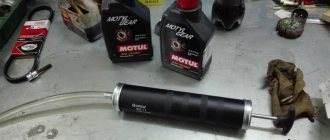The duration of trouble-free operation of the engine on the Lada Kalina largely depends on the choice of oil and its timely replacement. Today, there is a problem in the fuel and lubricants market in the form of counterfeits that “kill” engine elements.
Another factor is the correct selection of oil for the Lada Kalina 8 valve engine, which almost every owner of this car can encounter.
The video below shows a test of automobile oils for the Lada Kalina.
Choosing oil for the Lada Kalina 8 valve engine (poll: which oil is better)
The duration of trouble-free operation of the engine on the Lada Kalina largely depends on the choice of oil and its timely replacement. Today, there is a problem in the fuel and lubricants market in the form of counterfeits that “kill” engine elements.
Another factor is the correct selection of oil for the Lada Kalina 8 valve engine, which almost every owner of this car can encounter.
The video below shows a test of automobile oils for the Lada Kalina.
Synthetic or semi-synthetic
Currently there is a very extensive selection of oils
The manufacturer recommends only semi-synthetics. However, some car owners use synthetic oil, since it makes it easier for the engine to start in severe frost.
Pros of synthetic oil
Even though synthetic oil has better consumer qualities, it is still necessary to carefully monitor engine operation (vibration, speed, operating temperature (by the way, what is the operating temperature of an 8-valve engine?).
A very interesting video from “ICE Theory” about choosing oil
If you are interested in this question, be sure to watch the video below.
Source
Why do you need an oil change (theory of the issue)
This is what oil looks like with a mileage of 10,000 km from a Lada Kalina engine
Any oil has its own resource and production. Depending on the type and labeling of fuel and lubricants, its use may vary. This is influenced by technical and chemical properties, as well as the type of engine, number of valves and cylinders. Find out more about choosing oil for a 16-valve engine here!
For the 8-valve Lada Kalina, the manufacturer has compiled a whole technological scheme of oils acceptable for use. If you pour fuel that is not recommended for use, you can get unpleasant consequences. This could be a major engine overhaul or a complete replacement of the power unit, so it is worth buying oil with the recommended marking.
Technical and chemical properties of oils
Engine oil must perform several functions:
- Excellent lubrication of components and parts of the internal structure.
- Cool hot parts.
- Protect from corrosion damage.
Thus, the engine oil must have all the physical and chemical properties that will protect the engine and provide maximum service life before major repairs.
A little about the engine
The Lada Granta is equipped with engines that are exactly the same as those on the Priora and Kalina. Therefore, when choosing oil, you can be guided by the advice of these car owners.
There are three 8-valve engines on the Lada Granta: 82 hp. (index 11183, valves do not bend) and 87 hp. (index 11186, 21116, valve bends).
Which oil is best to use for the 8-valve Lada Kalina engine?
Mobil Ultra - proven and recommended by Kalinovods
Lukoil LUX 5w-40 - in tests it is not inferior to its famous competitors
For the Lada Kalina 8-valve engine, I have developed a special table for the use of motor oils that are recommended for use.
Table of motor oils recommended for use from AvtoVAZ for Lada Kalina
The internal combustion engine can be filled with both synthetic and semi-synthetic fuels and lubricants. The use of mineral oils is highly discouraged. This factor is laid down not only by the domestic car manufacturer, but also by the association of automobile manufacturers.
After the transition to the use of injection engines occurred, automobile giants came to the conclusion that it was not worth filling engines with mineral fuels and lubricants, which only create carbon deposits on the walls of the combustion chamber. For carburetor versions of engines, mineral water is recommended for use.
Thus, let's consider what oil markings can be used for Lada Kalina 8 valves, as well as recommended manufacturers:
| Oil brand | SAE class | Group |
| Lukoil-Lux | 0W-40, 5W-20, 5W-30, 5W-40, 5W-50, 10W-30, 10W-40 | SL/CF |
| Luxe (Hit and Best) | 10W-40 | SL/CF SJ/CF |
| Novoil Super | 5W-30, 5W-40, 10W-40, 15W-30, 15W-40, 20W-40, 20W-50 | SJ/CF |
| RosNeft Maximum | 5W-40, 10W-40 | SL/CF |
| RosNeft Premium | 5W-40 | SL/CF |
| TatNeft Synthetic | 0W-40, 5W-30, 5W-40 | SM/CF |
| TatNeft Ultra | 5W-30, 5W-40, 10W-40 | SL/CF |
| Esso Ultra | 10W-40 | SJ/SL/CF |
| Mobile 1 | 0W-40, 5W-50, 5W-40, 10W-40 | SJ/SM/SL/CF |
| Shell | 5W-40, 10W-40 | SL/CF SM/CF |
| ZIC A | 5W-30, 10W-30, 10W-40 | SL |
Shell Helix 5w-40 engine oil - recommended by Kalinovoda from our portal
The table shows that there is a fairly large selection of oils for the 8-valve Kalina and any car enthusiast, based on this list, can pour the recommended amount of oil into the engine without fear.
Consequences of untimely oil changes (photos and videos)
As you know, from the technical documentation, the 8-valve Lada Kalina requires an oil change every 8-10 thousand kilometers. At the same time, the oil filter element is changed, which has the same service life as fuel and lubricants.
The consequences of untimely oil changes on the 8-valve Lada Kalina can be:
- Increased wear of the piston group, namely: pistons, oil rings, main and connecting rod bearings.
- Increased production of combustion chamber walls.
- Accumulation of carbon deposits on the walls of the block.
- Overheating of the motor due to the appearance of scale.
- Corrosion damage to the block.
- Contamination of oil channels.
The engine is still running well, thanks to timely oil changes and compliance with the rules for its operation and selection.
The worst case scenario for a late oil change could be a major overhaul of the engine, as it will “knock.” Less unpleasant consequences may include deflection of the cylinder head, increased wear of the crankshaft and camshaft, and replacement of the piston group.
Technological process of changing the oil (brief educational program)
Changing the oil on an 8-valve Lada Kalina is quite simple and does not require special knowledge. Let's consider the main stages of the technological process:
- Engine cooling. The engine must cool completely.
- We dismantle the lower protection and install the container.
Container for “working off” in the form of an old basin
The drain plug is indicated by a square and an arrow.
We ALWAYS lubricate the filter!
conclusions
If you follow all the recommendations and choose the right oil, and also change it on time, then the engine can last up to 300 thousand km without major repairs. You should always pay attention to the country of manufacture, since the market is saturated with fakes of unknown origin.
What can we say about oils and recommendations! - even from the car manufacturer? Nothing, everything goes like an advertisement, “Luk-Oil” pays for advertising, we pour “Luk-Oil”, and everyone is happy, but in reality - we need to pour what is available through media, even if it’s cheap and doesn’t wear out for long, not 5- 6 thousand km, but verified, but it’s better to use a service station
I personally fill it with Mobil 1. The engine is happy, and so am I. There are a lot of good oils now, if only there was money.
It is important to fill in the oil recommended by the factory. And there is no need to split hairs. You just need to observe the frequency of replacement and the motor will last a long time.
Kalina hatchback 2010 , 8 valve. 1.6, I fill up with Castrol Magnateg, it’s not cheap, the engine works properly, saving leads to different results,
Only children pour oil into the filter, where does the air go and how not to tear it?
People ! There is no need to pour oil into the filter) There is a channel on YouTube “Denis Mechanic” They popularly explain why this should not be done)
Source
Choosing oil for the Lada Kalina 8 valve engine (poll: which oil is better)
A car manufacturing plant always recommends the use of fuels and lubricants of certain brands. As for gasoline, Kalina-2 owners are advised to refuel their cars with the following brand of fuel: “Premium Euro-95” (GOST R-51866). In fact, any gasoline with an octane rating of 95 will do, but the instructions state that the fuel must not contain metal additives (lead, iron, manganese). Such additives are the basis of anti-knock mixtures.
Oil properties
Especially for the Lada Kalina, AvtoVAZ has prepared a whole technological scheme that you need to follow when choosing the right oil. First, let’s look at why engine oil is so useful in general:
- Oil lubricates the internal parts of the engine, and thus cleans it of dirt deposits.
- The oil is designed for more efficient cooling of parts heated to a critical temperature
- The oil protects the internal combustion engine from various corrosive effects on the internal components of the internal combustion engine.
Engine oil for Lada Kalina
Kalina is a small class variant produced by the automaker since 2004. The first generation had a station wagon and a sedan body, had 1.6 liter petrol units with a five-speed gearbox. The oil required for filling is indicated in the operating documents for the model.
TOTAL specialists offer synthetic fluid QUARTZ 9000, viscosity 5W40, which guarantees high-quality protection of the power unit from wear in arbitrary operating modes, thanks to the addition of special additives. It prevents the formation of various harmful deposits. Oxidative stability makes it possible to use this lubricant for a long period of time. Compliance with ACEA and API standards allows it to be used in power units of any modifications and generations of Lada Kalina.
QUARTZ 7000 lubricant with a viscosity of 10W40, which has high-quality protective properties, should be poured into units with high mileage. Due to its viscosity, it reliably lubricates components and parts with increased clearances due to wear, which significantly increases the service life of the engine. A complex of dispersing additives protects the unit from deposits and cleans the engine. Oxidation resistance ensures long mileage without fluid changes.
We hope our review helped answer the question that concerns you - Which oil is better to fill in the Lada Kalina 8-valve engine? We ask you to share your experience on replacing the lubricant in a Lada Kalina car under the review in the comments below.
Oil type
Lada Kalina engines support various types of oils - synthetic and semi-synthetic. The use of mineral oils is not recommended, according to the manufacturer's recommendations. Moreover, this is an instruction not only from AvtoVAZ, but also from the Association of Automobile Manufacturers.
For reference, we note that the need for mineral lubrication disappeared after more modern injection engines appeared, replacing carburetor engines. Experts have come to the conclusion that the “mineral water” does not have any special value, but only creates carbon deposits on the walls of the combustion chamber. But this is a recommendation for injectors, while older carburetors are still more optimized for mineral oil.
Step-by-step instruction
Having installed your car on the inspection pit/overpass/lift, begin step-by-step operations to replace the mining, during which you must:
- raise the hood of the car;
- open the oil filler neck;
- clean the oil pan from dirt;
- place an empty container under the drain hole of the oil pan;
- Using a 17mm wrench, carefully unscrew the drain plug;
Important: you need to be careful when draining waste. Contact with skin may cause burns.
- after all the waste has drained, which takes about 10 minutes, screw the drain plug into place. Pre-clean it from dirt and waste residues;
- Using a special puller, unscrew the oil filter, not forgetting to replace the container with the drained oil;
New Lada: Lada Kalina: alternator belt tensioner, check and replacement | Blog about cars
Tip: If you don't have an oil filter remover, use a large screwdriver. To remove the filter, use a screwdriver to pierce its housing. Then, using a screwdriver as a wrench, unscrew the filter.
- Using a clean rag, thoroughly wipe the filter seat from dirt and waste residues;
- carefully pour motor lubricant into the new filter (about 300 ml) and lubricate the rubber sealing gasket with it;
- Carefully install the oil filter, tightening it by hand. After the rubber sealing gasket comes into contact with the cylinder block, turn the filter another 3/4 turn;
- insert a funnel into the oil filler neck and pour new motor oil into the engine (somewhere around 3.2 liters). At the same time, do not forget to control the level of auto-lubrication in the crankcase of the power unit using a dipstick. A level is considered normal when the mark is in the middle between the MIN and MAX marks. If the mark is located above the MAX mark, then drain the excess auto-lubricant by unscrewing the drain plug;
- Pour a sufficient amount of engine oil into the engine, tighten the filler neck with a plug, having previously cleaned it of dirt and traces of carbon deposits.
- This completes the oil change process. Before starting the engine for the first time, it is recommended to check for signs of leakage on or under the engine.
If no leaks are detected, then the power unit can be started. The first time they run it for 1-2 minutes. During this time, the red emergency oil pressure warning lamp located on the instrument panel should go out. If the warning light goes out within a few seconds, then the work has been done efficiently and you can drive out onto the road.
Advantages and disadvantages
The advantage of the 11183 engine is the cylinder head of the original design. However, it was subsequently further modified into the ICE 11186, adding volume to the combustion chambers. The downside is the generator belt tensioner - the drive is constantly over-tightened, a deflection of 10 mm is not ensured without slipping, so the belt life is reduced and it has to be changed more often. This defect was corrected only in the next version of the motor 11186.
The integrated catalytic collector assembly in the engine was initially unfinished:
When installing the engine on the Lada Granta, the cabin heat exchanger was connected to the thermostat in series. All the coolant passed through it along a small circuit, the response temperature error was 5 degrees instead of the required 2 degrees.
Markings
Let's look at oil manufacturers, as well as markings that can help you find out whether Lada Kalina supports a particular oil.
- Lukoil Lux. SAE class – QW-40, 10W-40, 5W30; group – SL/CF
- Luxe Hit/Best. SAE class – 10W-40; group – SL/CF
- Novile Super. SAE class – 5W-30, 20W-50, 15W-30; SJ/CF
- Rosneft Maximum/Premium. SAE class – 5W-40, 10W-40, 5W-40; SL/CF
- Tatneft Synthetic/Ultra. OW-40, 5W-30, 5W-40; SM/CF, SL/CF
- Esso Ultra. 10W-40, SJ/SL/CF
- Mobil 1.OW-40, 5W-50, 10W-40; SJ/SM/SL/CF
- Shell. 5W-40, 10W-40; SL/CF
- ZIC A. 5W-30, 10W-30; SL
As you can see, Lada Kalina owners have a wide selection of oils with different classes and standards. Based on these standards, a car enthusiast can safely fill in any oil from the specified list.
List of recommended brands
The Lada Kalina engine will work flawlessly if you use products approved by the manufacturer. Let's name the main recommended brands with which AvtoVAZ cooperates:
- Lukoil-Lux
- Luxe
- Novile Super
- Rosneft Maximum (Rosneft Maximum)
- Rosneft Premium (Rosneft Premium)
- TatNeft Synthetic
- TatNeft Ultra
- Esso Ultra
- Mobile 1
- Shell
- ZIC A
It is also noted that it is not recommended to use various additives, since modern oils already contain them.
All motor oils recommended for use
Engine oil is usually replaced along with a paper filter. This consumes 2900 ml of fluid (for versions with automatic transmission – 4100 ml). The intervals between replacements are indicated in the service book. Recommended materials for use:
| Brand | Viscosity SAE | Quality |
| Lukoil LUX | 15W40 | SL/CF (B5/D3) |
| Lukoil LUX semi-synthetics | 5W30, 5W40, 10W40 | SL/CF (B5/D3) |
| Lukoil LUX synthetic | 5W30, 5W40 | SN/CF (B6/D3) |
| Rosneft MAXIMUM (Angarsk, Novokuibyshevsk) | 5W40, 10W40 | SL/CF (B5/D3) |
| Rosneft PREMIUM (Angarsk) | 5W40 | SM/CF (B6/D3) |
| TNK MAGNUM SUPER | 5W30, 5W40, 10W40, 15W40, 15W50 | SL/SJ/CF (B5/D3) |
| Gazpromneft PREMIUM | 10W40 | SL/CF (B5/D3) |
| G-ENERGY S SYNTH, F SYNTH | 5W40, 10W40 | SL/CF (B5/D3) |
| G-ENERGY EXPERT L | 5W30, 5W40, 10W40 | SL/CF (B5/D3) |
| GT TURBO SM (Hanval INC) | 10W40 | SM (B5) |
| ESSO ULTRA | 10W40 | SL/SJ/CF (B5/D3) |
| MOBIL 1 ESP FORMULA | 5W30 | SN/SM/CF (B6/D3) |
| MOBIL 1 NEW LIFE, PEAK LIFE, SUPER 3000 X1 | 0W40, 5W40, 10W40, 5W50 | SN/SM/SL/SJ/CF (B6/D3) |
| MOBIL SUPER 2000 X1 | 0W40, 5W40, 10W40, 5W50 | SL/SJ/CF (B5/D3) |
| SHELL HELIX PLUS | 5W40, 10W40 | SL/CF (B5/D3) |
| SHELL HELIX ULTRA, HX7, HX8, PLUS EXTRA | 5W40, 10W40 | SM/CF (B6/D3) |
| ZIC A PLUS | 5W30, 10W30, 10W40 | SL (B5) |
To narrow the range of choices, be guided by the climatic conditions in which the car will be used. It is recommended to determine the viscosity class based on air temperature:
| lower limit | Viscosity grade | Upper limit |
| –35 and below | 0W40 | 30 |
| –30 | 5W30 | 25 |
| –30 | 5W40 | 35 |
| –25 | 10W30 | 25 |
| –25 | 10W40 | 35 |
| –20 | 15W40 | 45 |
| –20 | 20W50 | 45 and above |
It is recommended to change the oil at a service station (service station). , however, the owner himself can add liquid to the tank.
Adding oil to the expansion tank
The oil level is controlled as follows: when the engine is turned off, unscrew the diagnostic dipstick located near the cylinder head cover between the third and second cylinders. A secondary check is carried out no earlier than after 3–5 minutes. after topping up.
Remember that motor oils of different brands cannot be mixed. The same applies to materials made on different bases (synthetic/semi-synthetic). Be careful when choosing.
The factory usually fills it with semi-synthetic material with a viscosity of 5W30 produced by Rosneft OJSC. Check the information by opening the service book.
What happens if you don’t add oil on time?
According to the operating instructions, the oil for Lada Kalina is changed every 10 thousand km. In this case, not only the oil is replaced, but also the filter element, which, together with the fuel and lubricants (oil), has the same service life. If you neglect timely oil changes, there is a risk of encountering the following problems:
- Excessive wear and subsequent failure of engine parts. Among them we note pistons, oil scraper rings, as well as main and connecting rod bearings
- Deposition of a large amount of carbon deposits on the walls of the combustion chamber
- Deposition of a large amount of carbon deposits on the walls of the cylinder block
- Scale appears in the engine, which leads to overheating of the internal combustion engine
- Low anti-corrosion resistance
- Oil channels need cleaning due to large dirt deposits
- If you systematically refuse to change the oil, it may lead to a major overhaul of the engine - this is the worst case scenario. At best, there is a high probability of failure of the crankshaft and camshaft, which will need to be replaced. You will also have to update the piston group
Design Features
After modernizing the 21114 engine taken as a standard, the 11183 engine has the following design nuances:
To reduce manufacturing costs, a connecting rod-piston group, a pulley and a crankshaft flywheel from the 2110 engine are installed in the engine. The volumes of the combustion chambers are increased for the engine with the sole purpose of ensuring a compression ratio of 9.6 - 10.0.
The manufacturer does not provide hydraulic compensators in this internal combustion engine, therefore, on the one hand, the use of lower quality oil is allowed. On the other hand, the savings in the operating budget when using cheap lubricants are “eaten up” by the costs of periodically adjusting the valves in a service station, since the manufacturer recommends doing it more often.
The main attachments are driven by their own belts. The design of tensioners (for example, a generator) leaves much to be desired. But the internal combustion engine allows you to increase power in the following ways. Moreover, a reasonable boost does not require major repairs to be carried out more often than the established deadline.
Even without improving the performance, the engine is high-torque and torquey, and produces 200% of the service life declared by the manufacturer. The available repair dimensions of the piston group make it possible to increase the service life, taking into account several overhauls, up to a million kilometers.
What kind of oil to pour into the VAZ engine of Lada cars
April 30, 2022 LadaOnline 236 465 20
The first thing a new car owner has to deal with is finding out what technical fluids are in the car and how soon they should be replaced. The engine is considered the main unit, so most often they start with motor oil.
Let us remind you that AvtoVAZ installs the same type of power units on its models, so the recommendations on “what oil to fill in the engine” will be the same for all modern Lada cars (Granta, Priora, Kalina, Largus, Niva, Vesta or XRAY).
New Lada: Frequently asked questions - Official LADA website
AvtoVAZ installs the following engines on Lada cars:
| Engine model | Volume, l | Power, hp | Number of valves, pcs | Engine oil volume, l | Installed on cars |
| VAZ-21114 or VAZ-11183 | 1,6 | 81 | 8 | 3,5 | Granta and Kalina |
| VAZ-21116/11186/11189 | 1,6 | 87 | 8 | 3,5 | Granta, Kalina 2 and Priora, Largus |
| VAZ-21126 | 1,6 | 98 | 16 | 3.2 (2.9)* manual transmission 4.4 (4.1)* AMT | Priora, Kalina, Granta and Kalina 2 |
| VAZ-21127 | 1,6 | 106 | 16 | 3,5 | Priora, Kalina 2, Granta |
| VAZ-21126-77 | 1,6 | 118 | 16 | 3,5 | Granta Sport |
| VAZ-21128 | 1,8 | 98 | 16 | 3,5 | Priora |
| VAZ 11194 | 1,4 | 89 | 16 | 3,5 | Kalina |
| VAZ 21129 | 1,6 | 106 | 16 | 3,2 (2,9)* (1) 4,4 (4,1)* (2) | Vesta, Lada XRAY |
| VAZ 21214 | 1,7 | 81 | 8 | 3,75 | Niva 4x4 |
* - when changing the oil (with replacing the oil filter) (1) - stamped oil sump (AMT) (2) - cast oil sump (manual transmission)
We select Niva 4x4 engine oil in a separate article.
What motor oils are recommended by AvtoVAZ? If you open the Operating Manual for the car and its modifications, not the latest edition, you can find table No. 2 “Motor oils”. Comparing them for different Lada cars, you can understand that AvtoVAZ recommends the same motor oils for Lada Granta/Kalina/Priora engines.
For Lada Vesta, AvtoVAZ recommends using Rosneft brand motor oil, API class SL, SM or SN.
What brand of oil does the Lada come from the factory? Sometimes information about the filled engine oil is indicated on a tag under the hood. Most often, AvtoVAZ fills with Lukoil semi-synthetic/mineral motor oil. During maintenance, the manufacturer fills in ROSNEFT 5W-30 motor oil (semi-synthetic). You can add ROSNEFT Premium or ROSNEFT Maximum 5W-40 or 10W-40. Or Lukoil Genesis RN 5W-40.
You can determine the viscosity of engine oil using the following table:
| Minimum engine cold start temperature, C | Viscosity grade according to SAE J 300 | Maximum ambient temperature |
| Below -35 | 0W-30 | 25 |
| Below -35 | 0W-40 | 30 |
| -30 | 5W-30 | 25 |
| -30 | 5W-40 | 35 |
| -25 | 10W-30 | 25 |
| -25 | 10W-40 | 35 |
| -20 | 15W-40 | 45 |
| -15 | 20W-40 | 45 |
How to determine the composition of motor oil? To answer this question, we conducted surveys among owners of Lada Grant, Lada Kalina and Lada Priora, asking them to answer the question “What oil composition do you use in your car?” as a result, we received approximately the same results:
What brand of oil do you use? The next polls and very similar results:
The survey below will help you finally decide on the choice of engine oil. Take part in our survey and discussions. Let us remind you that the website contains instructions for changing engine oil, as well as recommendations on which engine oil is best to choose based on viscosity and composition. By the way, the HR16 engine is also installed on the Lada Vesta; read the recommendations on choosing lubricants for it. For Lada Largus with Renault K4M or K7M engine.
Keywords: Lada Priora engine | Lada Kalina engine | Lada Kalina 2 engine | Lada Granta engine | lubrication system for Lada Priora | lubrication system for Lada Kalina | lubrication system for Lada Kalina 2 | lubrication system for Lada Granta | Lada Vesta engine | lubrication system for Lada Vesta | Lada Largus engine | Niva engine | lada xray engine | lubrication system for Lada Largus | Niva lubrication system | Lada Xray lubrication system | universal article
>What kind of oil to pour into an 8-valve viburnum
Generation 1 (2004 - 2013)
Engine VAZ 21114/11183 1.6 8 valves 81 hp.
- When to change oil: 15000
Engine VAZ 11194 1.4 16 valves 89 hp.
- What kind of engine oil is filled from the factory (original): Synthetic 5W30
- Oil types (by viscosity): 5W-30, 5W-40, 10W-40, 15W-40
- How many liters of oil in the engine (total volume): 3.5 liters.
- Oil consumption per 1000 km: up to 100 ml.
- When to change oil: 15000
Engine Priora 21126 1.6 16 valves 98 hp
- What kind of engine oil is filled from the factory (original): Synthetic 5W30
- Oil types (by viscosity): 5W-30, 5W-40, 10W-40, 15W-40
- How many liters of oil in the engine (total volume): 3.5 liters.
- Oil consumption per 1000 km: up to 50 ml.
- When to change oil: 15000
Engine condition after using fuel and lubricants
When changing oil, you should refrain from using various additional additives - engine and transmission, since modern fuels and lubricants contain all the required components that allow all units and components of the vehicle to operate with maximum efficiency. Many car owners use ZIC A products for the engine and TNK Magnum for the gearbox. According to reviews, this combination is ideal for Kalina. Here is one review of their use: “Before the next replacement, I removed the valve cover to assess the condition of the camshaft. I was surprised by its perfect condition without soot. When filling and before draining, the level on the dipstick was the same. During operation, the engine did not make noise or vibrate. I was pleased. As for the gearbox, the TNK lubricant did not have much effect on extraneous noise, but gear shifting in the cold improved significantly.” Below is a photo of the engine from the author of this review. Judging by his comment, the car traveled 40 thousand km at one gas station.
Judging by the photo, it’s time to change the lubricant, but there are no deposits or deposits on the engine, the engine is clean. Some car owners try to buy this material in metal cans, since the likelihood of running into a fake in this case is lower. This article ends with a review from the same Lada Kalina owner, who ponders which transmission oil is best for Kalina, and which one makes sense to buy at the next replacement: “Next time I’ll try to fill in the Elf brand from Total. I've read a lot about it and haven't come across a single negative review. Photos of the engines confirm their excellent condition with a mileage of 300 thousand kilometers.”
The duration of uninterrupted operation of the power unit on the Lada Kalina with 8 valves depends on the use of the correct engine oil and its replacement in a timely manner. Today there is a problem with the spread of counterfeits that negatively affect the engine. Let's look at which oil is better to fill in the Lada Kalina 8 valve engine?
Malfunctions: causes, elimination
If the timing belt of the drive breaks, the 11183 motor does not bend the valve, but it has the following typical breakdowns:
| Floating speed | 1) malfunction of the ignition module 4) failure of the TPS sensor | 1) module replacement 2) installing a new gasket 4) repair or replacement of the throttle position sensor |
| Extraneous noise | 1) misadjustment of valve clearances 4) development of liners | 1)adjustment with valve gaskets 2) replacement of pistons, rings 4) use of new liners |
| Alternator belt break | excessive tension, manufacturing defect | Regular check, replacement as necessary |
Since a feature of the ICE 11183 is a well-thought-out design of valves and pistons, overhauls in most cases are carried out on time without additional user investment.
Why do you need an oil change (theory of the issue)
This is what oil looks like with a mileage of 10,000 km from a Lada Kalina engine
Any oil has its own resource and production. Depending on the type and labeling of fuel and lubricants, its use may vary. This is influenced by technical and chemical properties, as well as the type of engine, number of valves and cylinders. Find out more about choosing oil for a 16-valve engine here!
For the 8-valve Lada Kalina, the manufacturer has compiled a whole technological scheme of oils acceptable for use. If you pour fuel that is not recommended for use, you can get unpleasant consequences. This could be a major engine overhaul or a complete replacement of the power unit, so it is worth buying oil with the recommended marking.
Technical and chemical properties of oils
Engine oil must perform several functions:
- Excellent lubrication of components and parts of the internal structure.
- Cool hot parts.
- Protect from corrosion damage.
Thus, the engine oil must have all the physical and chemical properties that will protect the engine and provide maximum service life before major repairs.
Engine tuning
To improve the performance of the 11183 engine, several types of tuning can be used:
Practice shows that chip tuning for 8-valve internal combustion engines is not effective, and turbocharging leads to increased wear of parts, so these methods are rarely used.
For example, tuning by replacing the camshaft already adds about 10 hp. s., and in combination with other methods, the power increases to 120 hp. With.
Thus, the 11183 motor has a serious advantage - it does not bend the valves with pistons when the timing belt drive breaks. However, there are a number of shortcomings that were corrected only in later versions of engines from the manufacturer AvtoVAZ.
Source
How to choose an oil
No one knows his car and what it needs better than the car owner, so choosing oil is a purely individual process. It is worth taking into account not only the make of the car, but also the condition of its engine, the mileage of the car, the presence or absence of a turbine, and an important point is the fuel used. The choice is also influenced by the time of year in which the product is purchased and the operating conditions of the machine. For cars that sit in the garage most of the time, the lubricant should be changed every 10 thousand kilometers, but as practice shows in the conditions of the Russian climate and roads, this procedure will have to be carried out much more often, approximately every 5000 kilometers. It is worth relying on the data specified by the machine manufacturer in the instructions. If you change the lubricant less frequently, the resulting combustion products on the engine are unlikely to have a good effect on the performance of the entire machine.
Source

